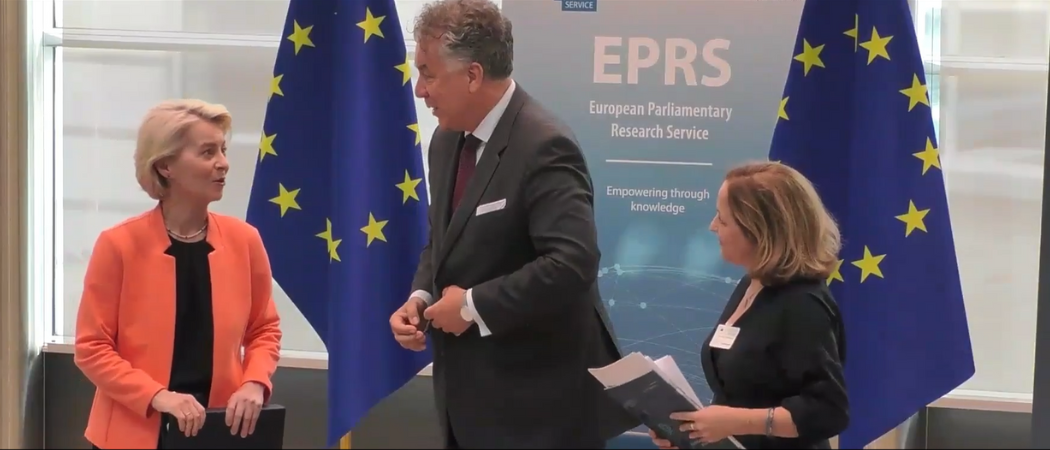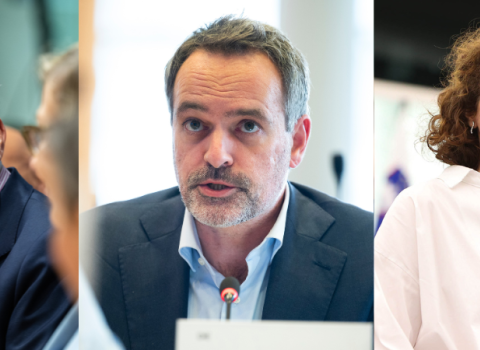EU research budget at greater risk of cuts if financial framework negotiations begin before FP10 detail is filled in, MEP warns

European Commission's President Ursula von der Leyen (left), MEP Christian Ehler (center), Spanish National Research Council's President Eloísa del Pino Matute (right). Photo credits: European Union
There is an urgent need to fill in the detail of FP10, the next EU research and innovation Framework Programme, following confirmation that a regulation to set it up will be published on July 16 alongside the new Multiannual Financial Framework (MFF).
“We don’t have much time now to formulate the outlines,” said Christian Ehler, the European People’s Party MEP who was rapporteur on the current Framework Programme, Horizon Europe. The rapporteur for the FP10 legislative procedure will be appointed only after the proposal is tabled by the Commission in July.
“If we start the MFF negotiations and we don't have a programme, the danger is much bigger that we get cut, because we would have a fairly empty financial proposal,” he warned.
Ehler was speaking with Science|Business on June 4 following a speech by European Commission president Ursula von der Leyen, in which she reaffirmed that FP10 would be a “self-standing” programme in the next budget cycle.
She also reiterated the close connection between FP10 and the planned European Competitiveness Fund which, she said, would support the full innovation lifecycle, helping turn breakthrough discoveries into transformative technologies.
“We must make Europe the best place in the world to pursue science, not only for fundamental research, but through the entire life cycle of innovation, from the university laboratory to world-leading unicorns,” she said.
Related articles:
- Von der Leyen speech on Competitiveness Fund sparks mixed reactions
- ‘Self-standing’ FP10 will be ‘tightly connected’ to European Competitiveness Fund, Von der Leyen says
When asked by Science|Business whether this close linkage between FP10 and the Competitiveness Fund might compromise the programme’s independence, Ehler expressed confidence in the approach.
“What I would envisage is simply that, along the innovation chain, we are kicking in much earlier with leveraged funding for commercialisation,” he said.
Structural changes
Ehler would like to see FP10 adopt a structure more closely aligned with the European Research Council model, with only broad guidelines set at the political level and implementation left to the research community.
“What we have learned in an ever-faster innovation setting globally is that we are too slow [. . .] and over-descriptive,” Ehler told Science|Business.
In particular, he thinks way in which the Commission and member states “co-created” Pillar 2 of Horizon Europe is now "dead," having made that part of the programme overly complex and politically entangled.
Ehler suggested that the evolving context could lead to a new type of proposal in which a small number of independent agencies operate under politically defined ambitions focused on competitiveness. Meanwhile, the design of specific work programmes would be left to industry and research experts.
A leaked chart obtained by Science|Business last month showed the Competitiveness Fund be structured around five main pillars, or a “small number of sectoral windows,” each supported by a common financial toolbox.
This approach recalls proposals by the Heitor group last October to establish a European Technology and Industrial Competitiveness Council to enhance private sector participation, and a European Societal Challenges Council to manage research and innovation activities addressing societal challenges with limited industry involvement.





 A unique international forum for public research organisations and companies to connect their external engagement with strategic interests around their R&D system.
A unique international forum for public research organisations and companies to connect their external engagement with strategic interests around their R&D system.